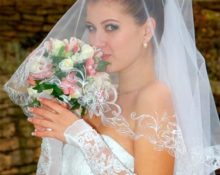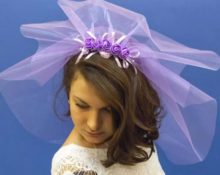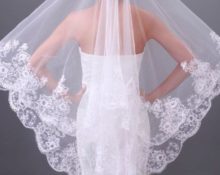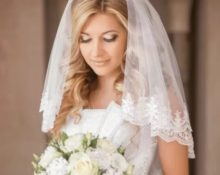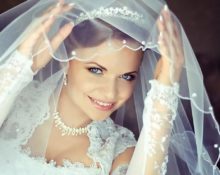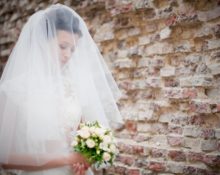The bride's wedding dress is always very beautiful. The veil plays a special role in it. What is it, what does it consist of, what does it symbolize and where did the custom of wearing it for the main celebration come from? Read on.
What kind of object is this - a veil?
This is a light blanket made of thin fabric that covers the head and goes down the shoulders to the waist.. The accessory consists of two continuous panels, which can be in the form of silk, muslin, lace, or tulle pieces of fabric. In recent decades, tulle or organza has been used as material.
Description of the veil
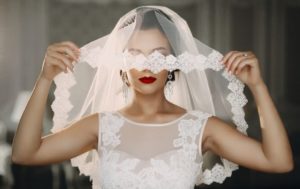 The attribute remains unchanged for a very long time. Both in the Middle Ages and in modern times, girls get married in a veil, before - only of a certain length, now - from short to long, for which assistants are needed. The accessory always matches the dress. Its style determines what length, shape, and what material the bride’s head covering should be made of.
The attribute remains unchanged for a very long time. Both in the Middle Ages and in modern times, girls get married in a veil, before - only of a certain length, now - from short to long, for which assistants are needed. The accessory always matches the dress. Its style determines what length, shape, and what material the bride’s head covering should be made of.
Modern wedding veils vary greatly in length. The veil can be of different types:
- short – up to 60 cm;
- medium – 70-110 cm;
- long – 110-350 cm.
This accessory is so beautiful that even the varieties of styles are represented by poetic names: veil, blusher, veil to the elbow, to the fingertips, fan, fountain, waltz, chapel, cathedral, mantilla. And the shape of the cover is round, cascading and in the shape of a cap - bridal cap.
Attribute assignment
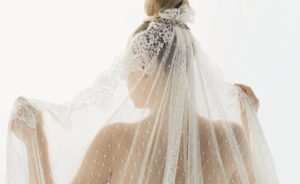 The veil is used as an integral and one of the important accessories of the bride’s wedding dress. It should be noted that it has long ceased to fulfill its main function - to hide the appearance and figure of a girl getting married. However, no other attribute of a wedding dress can give the bride so much grace and beauty.
The veil is used as an integral and one of the important accessories of the bride’s wedding dress. It should be noted that it has long ceased to fulfill its main function - to hide the appearance and figure of a girl getting married. However, no other attribute of a wedding dress can give the bride so much grace and beauty.
It was not always just a wedding veil. At different times among the peoples of Europe and Asia, including Rus', it could be used as a headdress for a girl or married lady. Boyars walking down the street covered their faces, leaving only the eye area open.
Historical reference
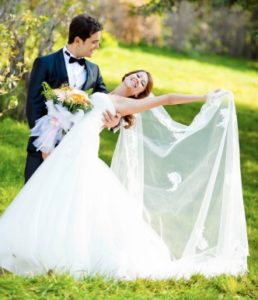 The head covering has been used as an indispensable wedding attribute since antiquity. In Ancient Greece, the newlywed was hidden under a yellow veil, and in Ancient Rome it was customary to protect the bride from the evil eye and evil spirits by covering her with a red cloth. According to tradition, it was necessary to hide not only the head, but also the entire torso under the cut. There were no transparent materials then; it was impossible to see the appearance and figure of the bride under the matte veil.
The head covering has been used as an indispensable wedding attribute since antiquity. In Ancient Greece, the newlywed was hidden under a yellow veil, and in Ancient Rome it was customary to protect the bride from the evil eye and evil spirits by covering her with a red cloth. According to tradition, it was necessary to hide not only the head, but also the entire torso under the cut. There were no transparent materials then; it was impossible to see the appearance and figure of the bride under the matte veil.
It was believed that the veil would protect the newlywed from being kidnapped by evil spirits. In the Middle Ages, crusading knights brought from their campaigns the eastern custom of marrying off girls wearing a white veil.
In Rus', the bride’s head at a wedding was covered with an ordinary scarf, but boyar daughters were married in an outfit with a thin light veil, which was secured with a metal or leather hoop. Over time the color of the veil changed to white, symbolizing the innocence and purity of the bride. Soon, instead of it, the cover began to be decorated with a wreath of flowers. At the end of the wedding feast, a custom was established to remove the bride’s veil in front of the guests; this served as the beginning of a new stage of life and indicated the transfer of power to the husband.
Advantages and disadvantages of a veil in a wedding look
Not every modern bride decorates her outfit with a veil. Sometimes the wedding attribute is replaced with a beautiful hat, veil, flowers in the hair, or a tiara. If a girl can’t decide whether to wear a veil for a celebration or not, then it’s worth considering the pros and cons of using it in a wedding dress.
Some difficulties in use can be considered as disadvantages:
 inconvenience when moving caused by a long veil;
inconvenience when moving caused by a long veil;- limited selection of hairstyles suitable for attaching the accessory;
- the impossibility of demonstrating the interesting cut of the dress, embroidery, open shoulders, graceful figure hidden under the cover.
Any girl in a wedding dress looks like a princess, and with a veil the magic only intensifies. The wedding attribute has undeniable strengths. It is necessary if you need:
- follow ancient traditions;
- gain confidence and calmness under the veil that hides the face during the most exciting moments of the celebration;
- hide imperfections in the cut of the dress, imperfect figure or skin;
- create many different images and scenes using veils in photographs from the celebration.
Important! It is not customary to wear a white veil - a symbol of innocence for brides in an interesting position or those getting married not for the first time.
Features of choosing a veil
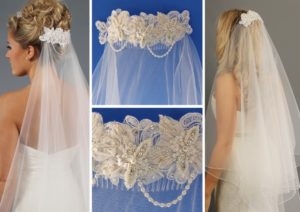 Wedding salons and shops present a huge variety of models and styles. Here you can choose a veil of absolutely any length from different fabrics. But in the selection, its combination with the dress will play a decisive role. For a lush outfit with flashy trim, you need to choose a modest cover. If the cut of the dress is simple, then an embroidered multi-layered accessory will be a wonderful addition to it.
Wedding salons and shops present a huge variety of models and styles. Here you can choose a veil of absolutely any length from different fabrics. But in the selection, its combination with the dress will play a decisive role. For a lush outfit with flashy trim, you need to choose a modest cover. If the cut of the dress is simple, then an embroidered multi-layered accessory will be a wonderful addition to it.
You need to choose a long veil for a long dress, and a short accessory for a short outfit.. The most universal length for a wedding veil is medium, in which the upper tier covers the face, and the lower one ends on the back. Short girls should avoid wearing a veil that is too fluffy - the upper part of the figure may visually appear disproportionately wide. Brides with curvy figures should not weigh down their look with accessories with satin trim, embroidery, and other decorations - a simple veil without any frills will not emphasize what you want to hide on your special day.
Important! When choosing, pay attention to the method of attaching the cover: it should be securely attached to the hairstyle and not create discomfort.
Where else is the veil used?
In modern times, a new tradition has emerged - wear a veil to a bachelorette party. Of course, this is not a white wedding accessory, but a short, light fabric of bright color, which only indicates the girl as a bride.
And one more custom with a veil - this one the accessory may be present in the outfit of the bridesmaids, for whom outfits are sewn in the same color. At the request of the girl getting married, her closest friends should be her retinue, dressed in outfits that match the style of her wedding dress. Fabric, color, style, cut - all this is a figment of the imagination and the embodiment of the wishes of the newlywed.


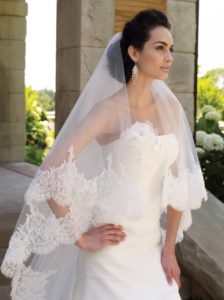 inconvenience when moving caused by a long veil;
inconvenience when moving caused by a long veil; 1
1